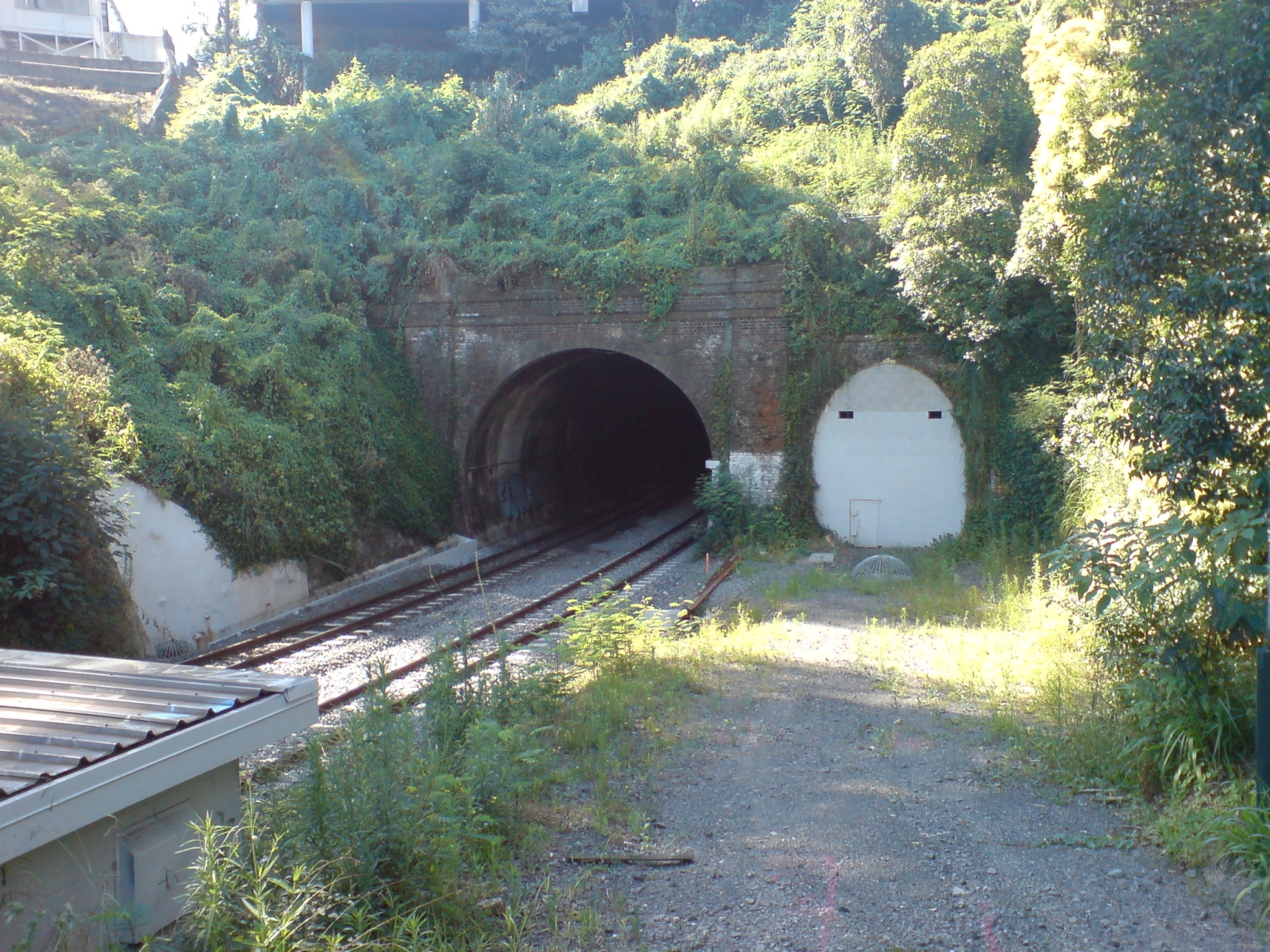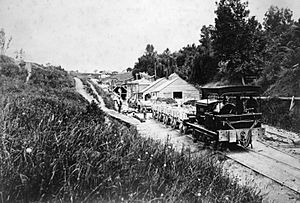Parnell Tunnel facts for kids
 |
|
| The southern portals of the newer double-track tunnel, and of the closed older single-track tunnel in 2011 | |
| Overview | |
|---|---|
| Line | Newmarket Line |
| Location | Parnell, Auckland, New Zealand |
| Coordinates | 36°51′43″S 174°46′53″E / 36.862°S 174.7815°E |
| Status | in use |
| Operation | |
| Work begun | 1864 (original tunnel) 1914 (second tunnel) |
| Closed | after 1930 (original tunnel) |
| Technical | |
| Length | 344.5 m (1,130 ft) |
| No. of tracks | 2 |
| Gauge | 1,067 mm (3 ft 6 in) |
The Parnell Tunnel is a railway tunnel located under Parnell in Auckland, New Zealand. It is about 344.5 meters (1,130 feet) long. This tunnel is an important part of the Newmarket Line railway system.
The tunnel helps trains from the Newmarket Train Station reach the Britomart Transport Centre. It allows them to pass under the Parnell Ridge and then go down to the harbor level.
There are actually two Parnell Tunnels. One is an older, single-track tunnel that is no longer used. The other is a newer, double-track tunnel that replaced it. The older tunnel has been closed for most of the last century.
The first tunnel was very important. It helped create Auckland's first public railway line. This opened up the city to other parts of New Zealand.
Contents
The First Parnell Tunnel
Work on the first tunnel began in 1864. It took a very long time to build, about nine years. This was partly because of money problems. Also, a huge landslide happened at the northern end, which caused long delays. The tunnel was finally completed in February 1873.
The first tunnel and its approach were quite steep. Trains often needed two engines to pull them up the slope. Sometimes, heavily loaded passenger trains would even stop inside the tunnel because of the steepness.
The tunnel was also known for filling with steam and smoke from the trains. This smoke would get into the passenger cars. During busy events, like race days, extra trains were used. These trains sometimes had open cattle wagons for passengers. Sparks from the engines would fly into these open wagons. This often caused small burn holes in people's clothes. Newspapers at the time would joke about this problem.
Because of these issues, the old tunnel was used less after the second tunnel was built. It was only used for moving trains around, not for passengers. It was fully closed sometime after 1930. During World War II, it was used as an air-raid shelter for people living in Parnell. Special gates were put at the entrances to protect against blasts.
Today, there's a plan to reopen this old tunnel. It could become a path for pedestrians and cyclists as part of new cycleway projects.
Building the Second Tunnel
Why a New Tunnel Was Needed
By the early 1900s, it was clear that the single-track tunnel was causing problems. It led to delays, discomfort, and even danger for trains. In 1905, the government planned to add a second track to the line south of the tunnel. However, this plan did not include duplicating the tunnel itself. Many people in Auckland were upset about this.
The Minister of Railways, Joseph Ward, initially said that duplicating the tunnel was not essential. He changed his mind after a meeting with 200 citizens. He said if ten important business leaders from Auckland asked for it, he would agree to build the second tunnel.
In 1910, Joseph Ward became New Zealand's Prime Minister. By then, the railway line on both sides of the tunnel had been duplicated. A city councilor brought up Ward's old promise. Newspapers noted that while a second tunnel was needed, the way it was being asked for seemed unusual.
A committee of ten men was formed in 1910. They looked into the issue, even though the government still resisted. In 1911, seven of the ten men recommended building a second tunnel. Three were against it. Some worried that a new tunnel would stop a goods shed from expanding. Others thought that train schedules could work around the single-track tunnel's limits. The government had argued that up to 240 trains could use the single tunnel daily. They felt the cost of £35,000-£40,000 for a new tunnel was too high. Because the committee wasn't fully in agreement, the duplication was again turned down.
However, many people in Auckland were unhappy. They saw the government building large tunnels in the South Island, like the Otira tunnel. Yet, the government claimed there was no money for the Parnell Tunnel. Groups like the Auckland Chamber of Commerce strongly pushed for the second tunnel.
There were also ideas for new railway lines that would avoid the steep slope to the Parnell Tunnel. These ideas may have made people doubt if the tunnel should be duplicated.
Finally, in 1912, it was agreed that the tunnel would be duplicated. However, funding was not immediately available. The plan to move the railway engine sheds also increased the pressure to build the second tunnel.
Building the New Tunnel
The new double-track tunnel was built between 1914 and 1915. Work started around April 1914 by widening the approaches to the tunnel. In January 1915, the first air shaft connecting the two tunnel sections was completed. The workforce grew from 50 to 140 people.
About 25,000 cubic yards of earth were removed. The tunnel shaft was about 25 feet 9 inches wide and 18 feet 2 inches high. The walls were made of concrete. Nearly three-quarters of a million bricks were used for the arch, in 4-6 layers. The second tunnel was also built with a less challenging slope than the first.
The new tunnel quickly improved train efficiency and safety. It allowed double tracks along the entire line between Britomart and Penrose. By 1926, about 150 trains passed through the tunnel every day.
Modern Upgrades
In January 2010, the tracks inside the Parnell Tunnel were removed. This happened during a summer closure of the railway network. The tunnel floor was lowered by 20 to 35 centimeters (8 to 14 inches). This work was done to prepare the tunnel for the electrification of the Auckland rail network.
Drainage for stormwater was also improved during this upgrade. Poor drainage had previously forced authorities to place speed limits on trains in the tunnel.


